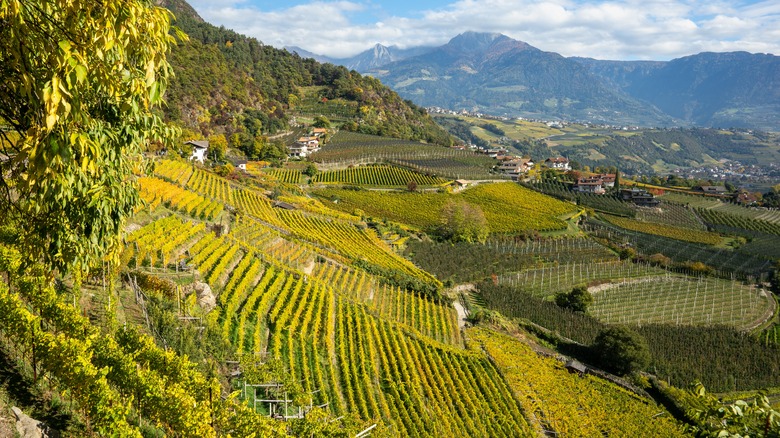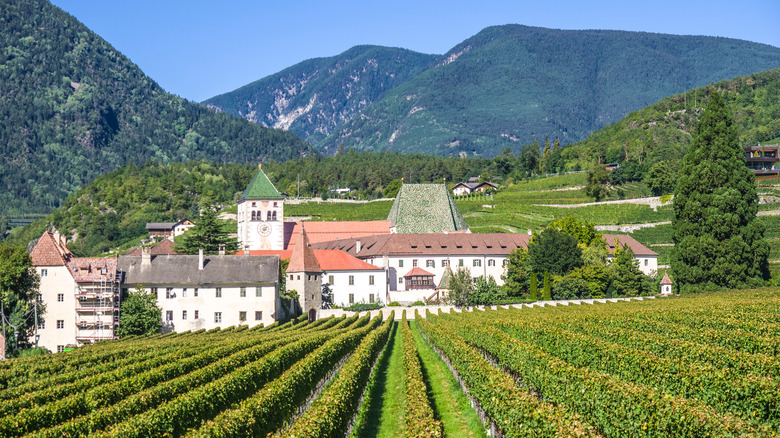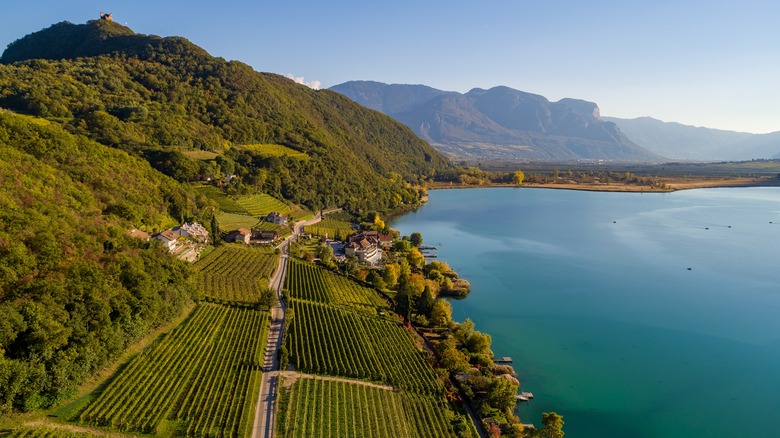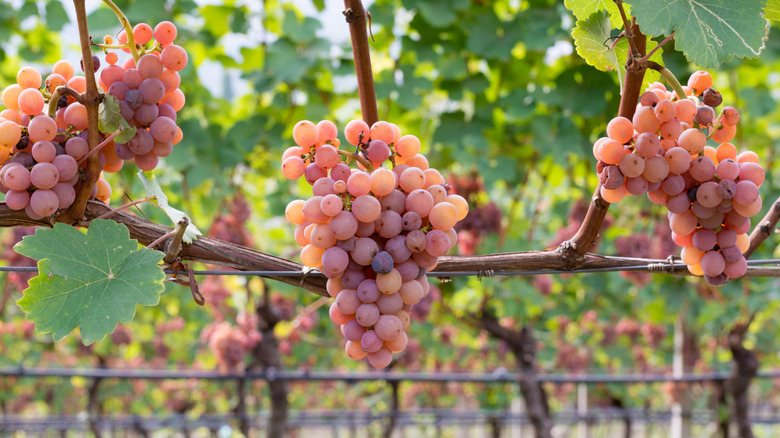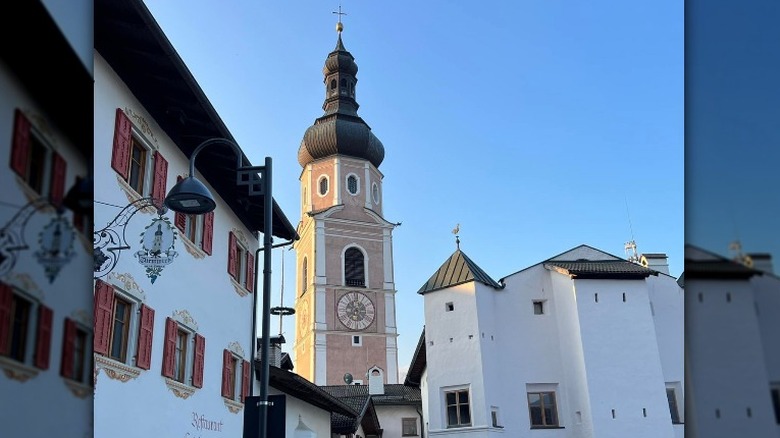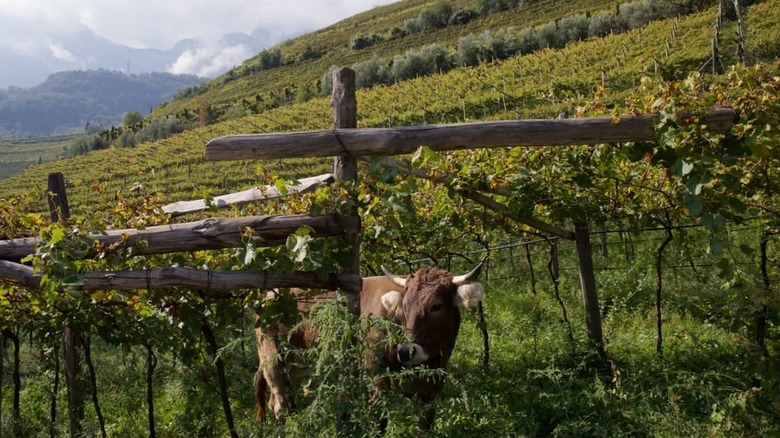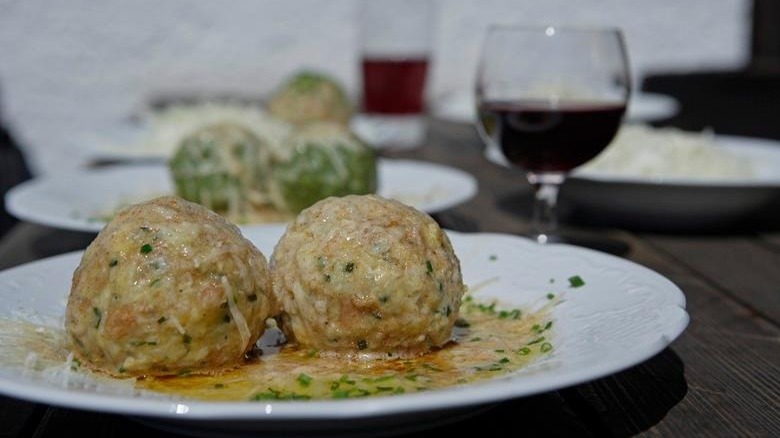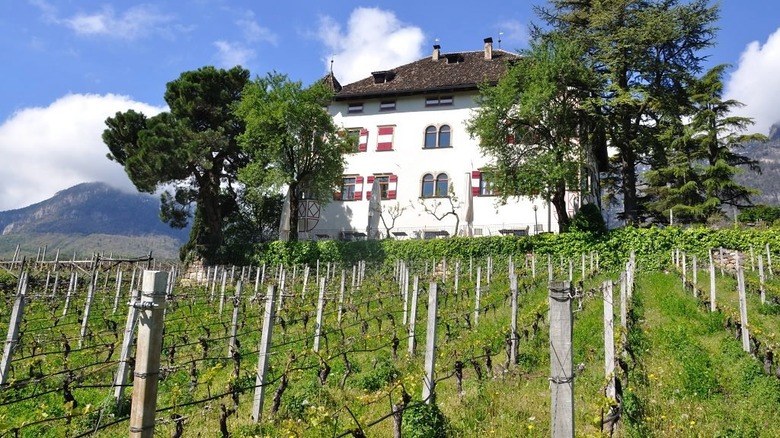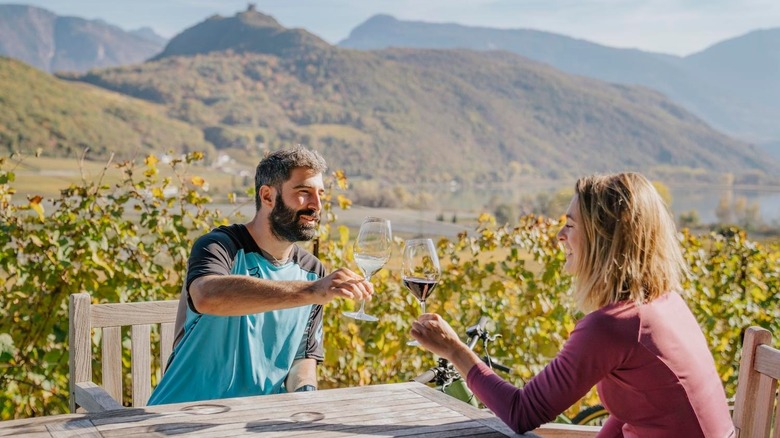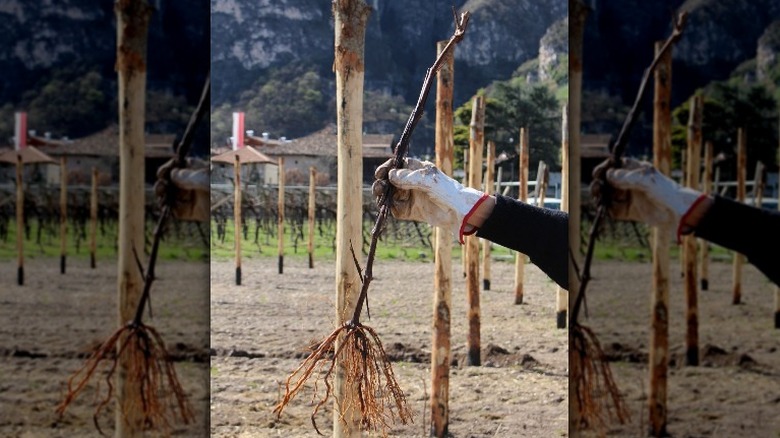The Beginner's Guide To Italy's South Tyrol Wine Region
If you have yet to take a deep dive into the vast world of Italian wine, you'll be forgiven for thinking that it only consists of Prosecco and Chianti. While those globally acclaimed wines see notable sales, there's more to the boot-shaped country's viticulture. With over 500 native grape varieties that account for more than a quarter of those worldwide, per Club Oenologique, drinking the same wines on repeat just won't cut it. The country's rich winemaking history spreads across 20 designated regions, each proudly displaying its own style.
South Tyrol (Alto Adige in Italian and Südtirol in German) boasts the northernmost location in the country, bordering Austria. For over 500 years, it was part of the Habsburg Monarchy and only joined Italy in 1919. With little more than a century in Italy, the area is undeniably distinct. According to the region's tourism board, 70% of locals speak German as a first language, compared with only 25% Italian.
Aside from the language, the cuisine has more in common with Austrian and German specialties than with classic Italian dishes. Similarly, viticultural and winemaking traditions stem back to a time when South Tyrol was not yet part of Italy. Discover everything about this small yet noteworthy region on the northern extremity of one of the world's top-producing wine nations.
The geography and geology are well-suited for vines
Although vines can grow in a wide range of climates and landscapes, there's a reason why some regions are acclaimed for producing exceptional wine. From climatic conditions such as temperature, sunlight, and precipitation, to aspects like proximity to bodies of water, altitude, and soil type, countless factors (referred to as terroir) influence how vines will fare. As it turns out, South Tyrol seems meant for vineyards, and that's not only the opinion of wine enthusiasts — science confirms it.
According to a 2020 study published in Agricultural Sciences, the area's location surrounded by the Alps results in an extensive spectrum of characteristics. From one vineyard to the next — and even within the same one — qualities best suited for certain grapes have been identified, forming the basis for 18 sub-zones. The detailed research and categorization mean that wineries can prioritize planting particular vines in specific areas of their vineyards.
Aside from in-depth analyses, it's clear that the region's geological past has set it up to be a prime grape grower. According to Südtirol Wein, the combination of glaciers, long-dried seas, and mountainous terrain result in around 150 types of rock, which offer suitable terrain for over 20 grape varieties. Paired with diverse microclimates influenced by lakes and mountains, plenty of sunlight (300 days a year, per The Vintner Project), as well as a significant range in altitude (around 650 feet to 3,300 feet), there's nothing monotonous about viticulture in South Tyrol.
History of viticulture in the region
Although South Tyrol might appear to be a recent arrival on the Italian wine scene, its origins trace back 3,000 years, says Südtirol Wein. Evidence such as grape seeds, wine vessels, and assorted winemaking equipment prove that the region has long been a source of wine. Whether it was used to satisfy the needs of the Romans or monks in monasteries, the rich history led to countless native grapes unique to the area. Furthermore, an Austrian wine pioneer planted international varieties over 150 years ago, paving the way for the current selection. Shortly after, an agricultural institute was founded to promote the research of cultivars and their growth.
In the early 1900s, producing large volumes of wine was the norm; consequently, quality wasn't at its prime (via The Vintner Project). Together with increased consumer interest in small-scale production, wineries began focusing on quality. More weight was placed on working in harmony with nature for both individual wineries and cooperatives of growers. Instead of prioritizing international grape varieties that weren't necessarily suited to the terroir, growers began to hone in on those that fit.
Around this time, DOC designations for the region were introduced, further emphasizing quality and geographical characteristics, notes Südtirol Wein. Winemakers also realized the value of implementing modern technologies. It was in the 1980s that South Tyrol's wines became more well-known and desirable on a national scale, eventually making their way to international markets.
Different sub-areas and their styles
Given that neighboring vineyards often display significantly different features, it's no surprise that the Alto Adige DOC is subdivided into zones, adds Südtirol Wein. The DOC covers about 98% of all wines produced in the area, providing a useful guideline for consumers about the contents of their glass. The main regions are Valle Isarco, Santa Maddalena, Terlano, Meranese, Valle Venosta, and Colli di Bolzano. Further subdivisions can be made to identify more specific winemaking guidelines.
Valle Isarco is the northernmost and oldest winemaking zone, and primarily produces crisp aromatic white wines thanks to the steep terrain and high altitudes (via Forbes). Given its northerly location, common German varieties like sylvaner, kerner, and riesling are mainly grown. Terlano also focuses on cultivating white grapes and international varieties like pinot blanc and chardonnay.
Santa Maddalena and Bolzano are known for their red wines thanks to additional heat from the sunny climate. In small quantities, the local grape schiava is the star cultivar along with other red grapes like lagrein and pinot noir. More reds are grown in the Meranese subregion, where high altitudes and sandy soils are the foundation for pinot noir, schiava, and merlot wines with gentle acidity and smooth tannins (via Great Italian Chefs). As for Valle Venosta, both red and white varieties flourish — gewürztraminer, sylvaner, müller thurgau, chardonnay, and pinot blanc, grigio, and noir are part of the mix.
Star grape varieties
South Tyrol grows indigenous and international varieties, making it ideal for discovering familiar and unfamiliar grapes. Südtirol Wein reports that white varieties outnumber red about two to one. Among the white grapes, pinot grigio reigns number one, followed closely by gewürztraminer, chardonnay, and pinot blanc. Sauvignon blanc is well represented, and the remaining varieties — müller thurgau, kerner, muscat, riesling, sylvaner, and veltliner — count for about 10% of all plantings.
Gewürztraminer vineyards are a dazzling spectacle of pink bunches, and the flavors are equally titillating with notes of tropical fruits and exotic spices. Meanwhile, the German varieties müller thurgau and kerner are hybrids that were bred to have desirable features in the vineyard. The former reveals floral aromas, minerality, and refreshing citrus qualities, while the latter is fruity with soft spice.
As for red varieties, schiava (or vernatsch) is a local favorite grown in similar quantities to lagrein (another indigenous grape) and pinot noir. Schiava is currently experiencing a peak in quality, ranging from light to full-bodied wines that showcase floral aromas, berries, and subtle spice. Although it risked extinction in the '70s, lagrein is once again harvested, offering dark berry, cherry, and violet notes that come together with spice and a rich velvety texture.
Small amounts of cabernet sauvignon, cabernet franc, and merlot are cultivated in warmer subregions. There are also several native grapes found in tiny proportions, making it especially exciting to get your hands on these rarer wines.
The influence of Germany's proximity
The fact that South Tyrol was under the rule of the Habsburg Monarchy for over 500 years contributed a great deal to its development. It has only been an Italian territory for a little over a century, the beginning of which was soured by the fascist regime (via South-Tirol.com). The region was forced to take on Italian culture with little regard for its rich history. Thankfully, in the last 50 years, the area has become an autonomous province, proud of its traditions and language.
A simple glance at a wine bottle from South Tyrol makes it clear; labels are often written in German, with an Italian translation sometimes included too (via wein.plus). As for grape varieties, brush up on your German to know that grauburgunder and weissburgunder refer to pinot grigio and pinot blanc respectively.
According to Exclusive Wine, back in the eighth century, countless vineyards in present-day South Tyrol were owned by Bavarian monasteries, and wines were drunk by German emperors. Wine Enthusiast concurs that local wines were enjoyed by the surrounding German-speaking regions in the Middle Ages. This audience undoubtedly influenced the choice of plantings and winemaking styles. Various grape varieties are originally from Germany or commonly grown there, like müller thurgau, riesling, kerner, and sylvaner.
Sustainability is a key feature
It's evident that South Tyroleans are proud of the local wonders. From dreamy landscapes and fresh mountain air to vineyards farmed in harmony with the earth, the region prioritizes nature. To commit to its dedication to future ecological improvements, The 2030 Alto Adige Wine Agenda focuses on five elements: soil, vines, wine, people, and territory.
The province of South Tyrol prioritizes renewable energy, which is equally relevant even though the impacts are not always obvious from a wine consumer standpoint. In the vineyards, sheep are commonly employed in lieu of tractors and machines to tame the rows (via Wine News). As wein.plus reports, organic vineyards and wineries have become increasingly widespread in the region — even considered to be a given for farmers — as vintners collaborate to let the terroir shine.
Given that many vineyards are family estates, the motivation to highlight the local tradition and heritage precludes much doctoring in the vineyard or cellar. Biodynamic farming, which improves balance in the ecosystem, is estimated to account for 5% of regional practices (via Seven Fifty Daily). Thanks to the crisp mountain air, low humidity, dry sunny climate, and superior soils, growers are assisted by natural conditions to cultivate quality vines without falling prey to pests or diseases.
Food pairings with local cuisine
The old adage "what grows together goes together," is always a safe bet. In South Tyrol, meals consisting of plates piled high with pasta and red sauce followed by gelato are replaced with dumplings, pork, and apple strudel (via The Guardian). As the Southern part of Austrian Tyrol, it's no surprise that dishes you'd expect from German-speaking regions are the norm.
Considering the prevalence of aromatic white wines, it bodes well that common recipes include fatty cuts of meat and tangy sides like sauerkraut. There are many ways to master the ideal pairing, such as by combining both complementary and contrasting tastes. High-acid whites with herbal, floral, and spice flavor profiles bring out the vinegar-based sauces while acting as the perfect palate cleanser for succulent meats. These versatile white wines also do a suitable job of pairing with trickier vegetables common in the local cuisine, including cabbage and asparagus.
Meanwhile, the red wines tend to display aromas of berries and spice which simultaneously pair with game meat, cured and smoked meat (Speck is a source of regional pride and even boasts its own geographical designation), and bolder mountain cheeses. Sometimes served with a light chill, they won't overwhelm your palate as you dig into a hearty meal.
Top wineries in the area
Although South Tyrol vineyards make up less than 1% of all grape-growing regions in Italy (per Wine News), there's no lack of options. The area counts over 200 wineries, including cooperatives, private establishments, and small-scale growers. The former is so important to the area that the Association of Winery Cooperatives of Alto Adige regulates the business to guarantee the finest products.
In some places, cooperatives are synonymous with low quality, however, the Northern Italian province has perfected the concept by rewarding growers who sell top-notch grapes (via Forbes). Customers are also on the winning end, as cooperatives such as the partnered Cantina Terlan and Cantina Andriano consistently produce excellent wines. The former happens to be the region's first cooperative from the late 1800s and a top source from which to try the DOC's foundational grape varieties, says Südtirol Wein. Kellerei Bozen is a benchmark for eco-friendly cultivation, while Cantina Tramin claims to be a prized terrain for gewürztraminer vines.
As for private wineries, Alois Lageder has been a family institution for almost two centuries and is a pioneer of biodynamics and sustainable farming in the area. The winery partners with numerous farmers in South Tyrol, truly showcasing the region's finest qualities. Meanwhile, Elena Walch and J. Hofstätter are other outstanding family wineries that produce bottles with international acclaim. Manincor is positioned at a dazzling location near Lake Caldaro and prides itself on upholding family traditions and biodynamic practices while highlighting the terroir.
How to visit the area
Given that around 75% of wines produced in South Tyrol remain in the country (via Wine News), it can be hard to taste them if you don't live in a metropolitan city with a diverse wine market. If a trip to Italy is in the cards, do yourself a favor and plan a stop in South Tyrol. Although Tuscany and Piedmont often steal the spotlight when it comes to wine regions to visit, be thankful that the northerly province isn't yet overwhelmed with international tourists.
Since its introduction in the '60s, the Alto Adige Wine Road has expanded to connect 16 villages and 70 wineries, over a distance of close to 100 miles. To simplify the process of exploring the mountainous region, the route is clearly indicated for navigation, allowing you to focus on choosing among the numerous establishments to visit. Not to mention, you'll want to keep your eyes on the winding road with its impressive landscapes, castles, and forts sprinkled all over. Plenty of options for accommodation are available, from simple rooms in bed and breakfasts to luxury mountain chalets.
With biking itineraries, wine safaris, and regular guided tours, there's no shortage of activities in the region. Meanwhile, if you want to soak up some history, the Alto Adige Wine Museum is an obvious source of education. If you find yourself in the area in the month of June, don't miss Wine Cellar Night, when local wineries stay open well past dusk.
What does the future of wine in the region look like?
With its emphasis on sustainable viticulture, while maintaining a strong sense of identity and tradition, South Tyrol is well poised for success. The region has proven to be capable of adapting to consumer interests as well as to discoveries gained from research (via The Vintner Project). As such, the local industry is prepared to integrate new technologies and knowledge in order to maintain its quality in the face of developments such as climate change.
Additionally, winemakers are realizing the importance of growing grape varieties best suited for the region as the climate evolves. From indigenous grapes to choosing those that ripen in accordance with shifting seasons, positive outcomes start in the vineyard. Similarly, an increasing number of winemakers in South Tyrol are prioritizing PIWI varieties, which are grapes crossed to be resistant to fungus and pests, eliminating the need for chemicals in the vineyard.
The 2030 Alto Adige Wine Agenda is a huge component of the area's path toward the future. By identifying measurable goals, progress in both ecological and economical sustainability can be clearly determined. Relying on natural methods to work in the vineyards can ultimately encourage the land to be more resilient and better able to endure unexpected conditions that await.

